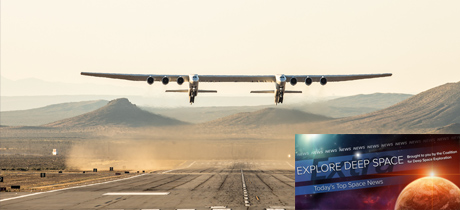In Today’s Deep Space Extra… As NASA moves out to accelerate a return to the surface of the Moon with astronauts from 2028 to 2024 potential international partners are assessing how they can fit in. NASA Administrator Jim Bridenstine acknowledges funding is a concern for advancing a lunar landing schedule. Israel’s SpaceIL pledges to rebound from last week’s failed Beresheet landing on the Moon with a second mission. Stratolaunch, the world’s largest airplane and a commercial airborne rocket launch platform, took to the skies over Mojave, California, for the first time on Saturday.
Human Space Exploration
NASA’s accelerated Moon plans create uncertainty for international partners
SpaceNews.com (4/14): In late March, the Trump administration directed NASA to accelerate a human return to the surface of the Moon from 2028 to 2024, a move that the agency’s prospective international partners are attempting to assess. Concerns arose during the annual Space Symposium last week in Colorado Springs. The internationals are looking primarily to partner with NASA for a lunar orbiting, human tended Gateway to which NASA’s Orion crew capsule would dock and that would serve as a command module for reusable surface landers and ascent vehicles. NASA anticipates a revision to its White House budget proposal for 2020 in order to address the accelerated schedule.
NASA’s plan to put humans on the Moon by 2024 is taking shape but will they get the money?
Houston Chronicle (4/13): NASA Administrator Jim Bridenstine returned to his Rice University Alma Mater Friday and Saturday to discuss the agency’s human deep space exploration plans. Funding, said Bridenstine, remains a challenge to efforts to assemble a lunar orbiting human tended Gateway that would serve as a staging asset for astronauts descending to the Moon’s surface and returning aboard reusable commercial landers and ascent vehicles. “Year by year funding is risky,” said Bridenstine. The White House has instructed NASA to return to the Moon’s surface with astronauts by 2024, four years earlier than previous planning.
Russia to send ‘outstanding citizens’ to space for free
TASS of Russia (4/13): In order to inspire domestic achievement, Russia intends to launch private citizens to the International Space Station (ISS) beginning in late 2021 under an agreement with U.S. based Space Adventures.
Space Science
SpaceIL chief: ‘Beresheet 2 starts Sunday; we’ll put our flag on the Moon’
Times of Israel (4/14): Beresheet, Israel’s bold attempt to place a privately financed lander on the Moon at the Sea of Serenity failed during landing on Thursday. However, SpaceIL, which built the spacecraft and launched the mission in February, intends to mount a follow on mission, possibly with crowd funding.
Going back to the Moon for science
The Hill (4/12): A look back at the late Paul Spudis, a prominent lunar scientist, who extolled the scientific riches a return to the Moon by NASA would provide. Among them, hints at the cosmic forces at work on the early Earth but covered over by the planet’s dynamic geology, a stable platform for observatories focused on deep space, and potential resources locked in the lunar soil, including water ice and metals. [Editor’s Note: Dr. Paul Spudis was a member of the Board of Advisors of the Coalition for Deep Space Exploration until his passing in 2018. More about Dr. Spudis may be found here: https://www.lpi.usra.edu/features/083018/paul-spudis/ ]
Possible 2nd planet spotted around Proxima Centauri
Space.com (4/12): During last week’s Breakthrough Discuss conference at the University of California, Berkeley, researchers from the University of Turin in Italy discussed the discovery of a possible second planet around the nearest star, Proxima Centauri. The red dwarf star lies 4.2 light years from the solar system.
Other News
Stratolaunch, plane dreamed up by Paul Allen, just became the world’s largest airplane ever to fly
Coalition Member in the News – Northrop Grumman
Washington Post (4/13): Saturday marked the first flight of the world’s largest airplane. Statolaunch, which has a wingspan larger than a football field, flew from the Mojave Air and Spaceport, north of Los Angeles. The test flight spanned 2 1/2 hours and reached an altitude of 17,000 feet. Built by Scaled Composites, a subsidiary of Northrop Grumman, Stratolaunch was designed to hold three rocket bodies for launches with small satellite payloads.
Putin vows all possible support to Russian space sector
TASS of Russia (4/13): Russian President Vladimir Putin is pledging future support for the nation’s space exploration efforts as part of overall national development. Putin spoke Friday during activities associated with Yuri’s Night, a celebration of the world’s first human spaceflight by cosmonaut Yuri Gagarin on April 12, 1961.
NASA icons named to Aviation Hall of Fame
Houston Chronicle (4/12): On Friday, the Texas Aviation Hall of Fame inducted Chris Kraft, NASA’s first flight director and a member of the Space Task Group that established the agency’s Apollo era human space flight program, and retired NASA astronaut Peggy Whitson, who holds the U.S. record for the most time accumulated in space, 665 days over three missions to the International Space Station (ISS).
Major Space Related Activities for the Week
Major space related activities for the week of April 14-27, 2019
Spacepolicyonline.com (4/14): Apollo 11’s Mike Collins speaks with veteran journalist Marvin Kalb from the National Press Club on Monday night, a presentation that will be webcast HERE at 7 p.m., EDT. A NASA contracted Northrop Grumman cargo mission to the six person International Space Station (ISS) is set to launch on a two day transit from Wallops Island, Virginia, on Wednesday. With Easter approaching, the U.S. House and Senate are on break.

